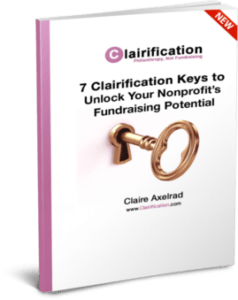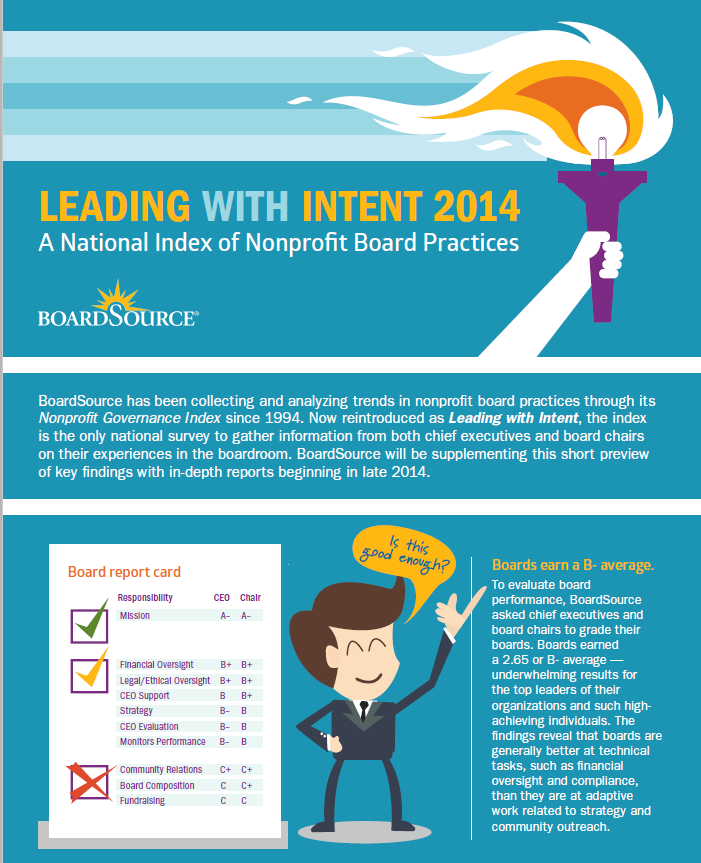
Ready to take the leap from your way to a new way?
Tomorrow is “leap day” — that little something extra we’re given every four years, just to slow things down a bit and make February last a bit longer.
Leap day has something in common with nonprofit boards of directors — that little something extra we’re given — volunteers put in charge of the business; something that sometimes has an unfortunate tendency to slow things down and make decision-making take a lot, lot longer than it should.
Sound familiar?
Work in a nonprofit organization for any period of time, and you’re likely to hear yourself or someone else complain:
” My board is driving me nuts! “
When asked by BoardSource, more than 1,000 nonprofit leaders gave nonprofits boards a “B-minus” grade in overall performance. Almost a third of nonprofit CEOs reported being unhappy with their boards’ support of them in their role as leader, and many of these folks were considering leaving their positions. When it comes to community relations and fundraising, CEOs rated their board members even worse — giving them a C! This is barely a passing grade.
Guess what? You may be driving your board members nuts too.
In a 2015 Survey on Board of Directors of Nonprofit Organizations by Stanford Business School, 69% of nonprofit board members say their organization has faced one or more serious governance-related problems in the past 10 years. There is a high level of dissatisfaction in a number of key areas, including:
- 65%do not believe members on their board are very experienced.
- 57% do not benchmark their performance against a peer group of similar organizations.
- 48% do not believe their fellow board members are very engaged.
- 46% have little to no confidence the data they review fully and accurately measures the success of their organization in achieving its mission.
- 32% are not satisfied with the board’s ability to evaluate the performance of the organization.
- 27% do not believe fellow board members have a strong understanding of the mission and strategy of their organization.
Do you administer a formal annual board satisfaction survey? It’s the best way to find out where you may be falling short in meeting your board members’ needs. Remember, most board members are well meaning. They want to help. They just don’t necessarily know how to help. It’s not something most folks learn in school.
Sadly, often neither boards nor staff leaders are satisfied with board service and performance.
How to Make Boards More Functional?
The very average level of board performance being reported by E.D.s currently should not be acceptable. Nor should the very average level of satisfaction reported by board members. We can do better. And to solve today’s most pressing problems, we must do better.
Is it time for a different model of board leadership? Anne Wallestad, President and CEO of BoardSource, provocatively asks: Are Nonprofit Boards Really Necessary? Ann plays with the notion of doing away with nonprofit boards entirely; then makes some valid points in support of board member leadership, guidance and a steadying hand in the face of a weak E.D. Yet, in practice, I’ve found just as much instability can come from a dysfunctional board as from an errant E.D.
What should a board be and do?
I’ve found boards, for the most part, to be enormously helpful – especially when it comes to financing the mission through both earned and contributed income strategies. So, for me, doing away with boards entirely is too draconian a solution.
Great boards are wonderful. And I generally find them in the same place I find a great E.D. It’s a match made in heaven. Other times, it’s like the blind leading the blind.
We may need some agreed-upon national standards of board composition, bylaws and job descriptions. How do E.D.s learn how to guide and support their boards? And vice-versa? Should board members be required to attend some sort of certification/training program? Should E.D.s be encouraged to attend with them?
It’s going to take some kind of a LEAP of faith — so this might be just the year to do it.
Problems with Current Leadership Model
Just like with individual psychoanalysis, organizational analysis can help you to become aware of potential problems. Once these are brought to light, you can begin to address them.
Here are some of the ways the nonprofit board leadership model can lead organizations astray:
1. Amateurs Advising Experts
Here’s how this works. Boards are often comprised of folks who consider themselves “professionals” (in their day jobs they may be doctors, lawyers, architects, financial advisors, developers, business owners and so forth), but who know much less about the business of the nonprofit (including fundraising and marketing) than do the equally professional staff who work there, and who were hired for their particular expertise.
I worked for 30+ years as a development/marketing director, and I was excellent at my job. Yet new board members were constantly suggesting to me ways to do my job. For some reason they never considered I might actually have already thought of these things — having done this job successfully for quite some time. I know they were trying to help. Yet this required hours of my time — saying “thanks so much… great suggestion… let me think about this… let’s set up a time to talk about this…and so forth — all gently leading them to a place where they could understand why their idea didn’t really make sense (unless it did, in which case I was delighted to collaborate).
One of the main reasons there is so much turnover in the fundraising profession (and I suspect the E.D. position as well) is that staff don’t feel respected by their boards.
2. ‘Community Boards’ vs. ‘Fundraising Boards.’
You want one board. A team of dedicated folks who understand their dual governance and financing roles. The best boards embrace their collective power, rather than separating themselves into cliques of them (advisors) and us (fundraisers) – each thinking the other is more valuable. That does not a happy dynamic make!
This holds true also for boards with requirements they be comprised of a certain percentage of “community representatives.” While this may sound lovely and egalitarian on paper, life is more three-dimensional. In practice, this can translate into board members who bring a sense of entitlement to the table, rather than an attitude of giving and helping. These members often don’t give and don’t ask.
There’s a problem when those in charge of establishing the mission, policies, strategic plan, programs and budget do not embrace the role of assuring resources are in place to fulfill this vision. Without financing, there’s no way to assure the decisions they make can actually be carried out. In government, we would call this an unfunded mandate.
A problem with labeling your board, or your members, differently is it works against achieving a common vision, mission and values.
3. Battleship Syndrome
Nonprofits get criticized for being slow to change. Ever heard someone say “this is like trying to turn a battleship around quickly?” Boards are one of the reasons why. They slow down decision-making because everything has to be determined by consensus.
Plus, making decisions by committee isn’t particularly effective. Everything can get watered down. There’s a tendency to cater to the lowest common denominator. And dangerous “group think” can set in, leading to emotion-driven decisions that can sometimes be quite extreme. Introducing new ideas can become a political mine field, and almost as challenging as trying to get a bill through today’s Congress.
Boards can also suck time from staff. But the E.D. can also be at fault. Often, the problem is a lack of agreement between the board and chief executive on the appropriate level of involvement in decision-making processes and on which decisions fall under the board’s purview.
Effective decision-making processes are among the top factors that enable effective board leadership.
4. Risk Aversion
Boards are naturally risk averse. It’s their job, after all, to be good stewards of donor resources. Yet in our digitally revolutionized world, where change happens at the speed of light (or faster!), nonprofits have to take risks. They have to be nimble. They have to adapt. And they have to embrace failure. If they don’t fail, they don’t grow. And if they don’t grow, they die.
Yet I’ve not run into many boards willing to embrace failure. Why would they? This is just their volunteer job. They don’t want to be sued. But the importance of failure as a learning opportunity should not be overlooked.
“A United Nations that is properly serving the world’s people is one that is always reflecting on its work, learning from realities on the ground and finding improved ways to respond to the world’s needs and opportunities.”
— Secretary General Ban Ki-moon, in his first time addressing the United Nations Joint Meeting of the Executive Boards
5. E.D./Board Chair Tension
Too often, boards simply rubber stamp whatever the staff leader wants without taking time to carefully evaluate the course of action. Alternatively, the board leader micromanages the staff leader, making it challenging for them to do their job effectively. Both of these scenarios are unhealthy.
Perhaps the best sign of a healthy nonprofit is a healthy partnership between the board chair and the executive director. So says nonprofit management and leadership expert Joan Garry, and I concur. These five elements are key to a successful leadership relationship. Truly, the relationship between your chief staff and lay leaders is critical to the success of your organization’s mission.
What the Board Does Matters
We all naturally want to follow the leader.
You see, it’s not what we say that really matters. It’s what we do. People won’t magically fall in line behind us just because we have a good case for support. Lots of organizations have a good case for support. Something needs to move us up to, and over, the line. And people will line up behind a leader way before they’ll step up to the line on their own.
- Foundations and businesses will ask what the board is doing before they commit.
- Potential individual donors will decide how much to give based on the size of gifts committed by the board.
- New board members will decide whether they can abstain from fundraising – and meeting attendance, meeting preparation, giving and leading — based on the level of involvement in which they see existing board members engaged.
- And so on.
Absent a board and executive director who lead by positive example it will be extremely difficult for any social benefit organization to survive and thrive.
What to Include in Your New Model
-
Assure your board is comprised of individuals with skills, resources, generosity, diversity and dedication that address your organization’s needs. Determine your needs and recruit and interview for specific qualities.
-
Assure you have a written board member job description, explicitly defining the role and responsibilities of board members to best leverage their time and resources.
-
Assure your board members understand, and are supported in, their governance role and financing responsibilities. Do this through transparent recruitment, thoughtful orientation, ongoing board development and formal, annual self-assessment.
-
Assure your board and staff align around a strategic plan directly tied to achieving your mission. Include clear, enumerated goals, objectives and strategies.
-
Assure your board chair and executive director regularly communicate and collaborate. Their relationship sets an important precedent for other relationships.
-
Assure development and tracking of clear performance metrics reflecting your goals, objectives and strategies.
-
Assure your executive director is held accountable for meeting performance metrics, and annually evaluate their performance using an objective process.
-
Assure you have well-defined committee structures and job descriptions to meet your organization’s needs and facilitate optimal handling of key decisions.
-
Bring in some decision-making tools to clarify responsibilities and streamline decision-making.
-
Assure you plan carefully for a leadership pipeline, both in terms of executive management succession planning and board development and mentoring.
What do you think can be done? Please leave your ideas in the comments section below.
Happy (take the) Leap Day.
Want to get your staff and board leaders on the same page?
 Consider working through the exercises in the 7 Clairification Keys to Unlock Your Nonprofit’s Fundraising Potential together. It will put the focus on issues, not personalities. I guarantee you’ll learn a lot.
Consider working through the exercises in the 7 Clairification Keys to Unlock Your Nonprofit’s Fundraising Potential together. It will put the focus on issues, not personalities. I guarantee you’ll learn a lot.
As with all Clairification products, this comes with a 30-day, no-questions-asked, 100% refund guarantee. You can’t lose.
To your success!
Photo courtesy of me (my own collage). Infographic courtesy of Board Source, Leading with Intent, a National Index of Nonprofit Board Practices.




